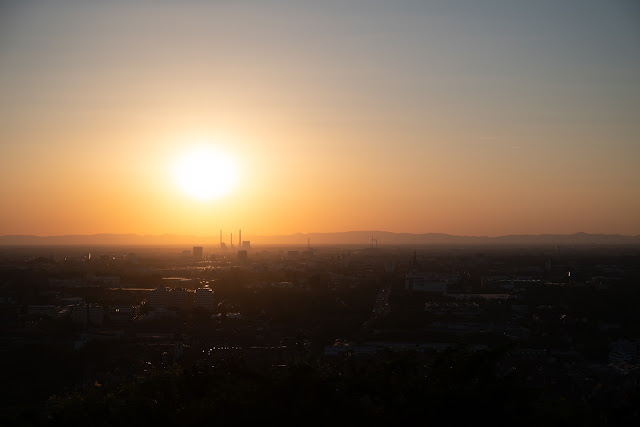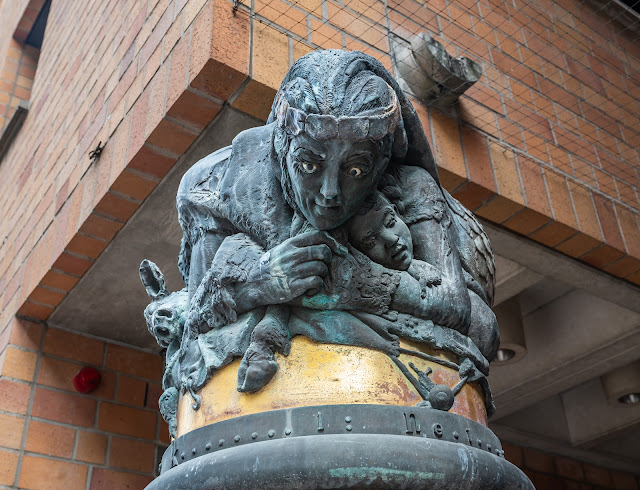Nikon Z 24-70 f/4 - Review as Walk-Around Lens
 |
| ƒ/5,61/100070mmISO100 |
I have now been shooting almost all pictures on my holiday trip with the Nikon Z 24-70 f/4. This is a report on my experience under this restriction, adding some advice for you travel photographers out there. Take everything with a grain of salt. Your milage may vary.
The first obvious question if you followed this blog is: Why not use my 24-200 f/4-6.3? The lens only loses one stop at 70mm, and offers more flexibility with its range up to 200mm. It is a bit larger, but not much heavier. My reason, however, is that I use 24mm very often, and that this is the weak spot of the 24-200mm. I wanted perfect sharpness and well corrected chromatic aberration.
The 24-70 f/4 is also superior at 70mm. The image above is a famous view over the Rhein valley near Karlsruhe. There is a hill with a tower where people come to see the sunset when the weather allows, especially in summer. The view is spectacular.
The image may look like an easy shot. But I can tell you that most lenses would produce flare all over the frame and much less sharpness. The nice rendering of the sky colors is also due to the full frame sensor of the Nikon Z5.
In the end, it is the quality of this lens which draws me to it, disregarding the missing telephoto range. Gear does matter.
 |
| ƒ/91/8024mmISO100 |
Here is an example of a 24mm shot with somewhat harsh light, taken at the BUGA in Mannheim. Correct post-processing is crucial here to avoid overblowing the sculpture with the bright background. I have another image where the foot is sharp. But I prefer to have the face in focus. Both is not possible, even at f/9 and 24mm.
This brings me to the selection of a good f-stop. The lens has the best balance of sharpness across the frame at f/5.6. The center sharpness is almost as good as wide open, and the lens is very good off-center at that aperture. Thus, I have a user mode for aperture priority at f/5.6, and use it all the time. Unless you get too close to subjects, everything will be sharp at 24mm. If you include close subjects, you get a blurred background with enough DOF.
The problem is that you might find the DOF not enough for group shots at 50-70mm. Always remember to close down on the long end, if there are people in different distances. One person sharp and the other slightly blurry simply does not look good. If you are using this lens exclusively, I suggest one user mode at f/5.6 and another one at f/9.
 |
| ƒ/5,61/4033mmISO140 |
This is one at f/5.6 and 33mm. As you see, you get only mild background blurriness with minimal object separation. However, I wanted DOF big enough to get the complete sculpture in sharpness. The image needed editing, because the light was bad. There is also some dodge and burn to make the face of the child more prominent.
 |
| ƒ/4,51/125042mmISO100 |
This is a similar one at 42mm which would work better with a 50mm at f/2.8 if you wanted to isolate the subject better. That is the kind of compromise you have to make. There is the expensive 24-70mm f/2.8 which could do this scene, or you could simply use the 50mm f/1.8. Note, that getting closer and shooting at 24mm does not help and only adds more distortion.
The 24mm end is also good for panoramas. You need fewer overlapping images on the wide end. I stitched the image above with Lightroom Classic simply. Most of the time, it just comes out perfectly.
How about the size of the lens, compared to similar options? Below is are the 24-70 f/4, the 24-200 f/4-6.3, and the 24-70 f/2.8. The lenses range from 500g-630g, so not too much difference here. But for me, the size matters. The professional f/2.8 would be too bulky as a travel lens. It is the lens to take for wedding shoots or similar.
The newer 24-120mm f/4 is an alternative, of course, albeit a lot more expensive. While you can get a 24-70 f/4 for around 400€ in good condition, the 24-120mm f/4 is over 1000€. It is also a lot bulkier, more comparable to the 24-70 f/2.8.
In summary, the 24-70 f/4 is a very compact, but still excellent lens. You will find no equivalent lens on other systems. There is a 16-55 f/2.8 for Fuji. But it does not offer any size advantage despite of the APS-C sensor.
In the end, the only question you have to answer for a travel zoom is if you can do without the 70-200mm range. I would love to add a 70-300mm of reasonable quality, but not too bulky. Personally, I have little need for that extra range in towns. But if I did landscape photography with only one lens, it might have to be the 24-200mm. The telephoto range is surprisingly useful to compress the scene.
Of course, a prime lens offers apertures that are simply not available with such a zoom lens. And it has even better image quality. Taking my 50mm f/1.8 into a museum or theater gives me more options for light and object isolation. The 105mm f/2.8 macro lens is so excellent that I use it whenever possible. The difference is visible.
Finally, some more images taken with the 24-70mm. Most of them could have been taken with just any lens and good technique. But having the versatile zoom range with me makes the difference. Flexibility and reliability are the key points here.
 |
| ƒ/5,61/64070mmISO100 |
 |
| ƒ/7,11/531mmISO100 |
 |
| ƒ/5,61/50026,5mmISO100 |


Comments
Post a Comment